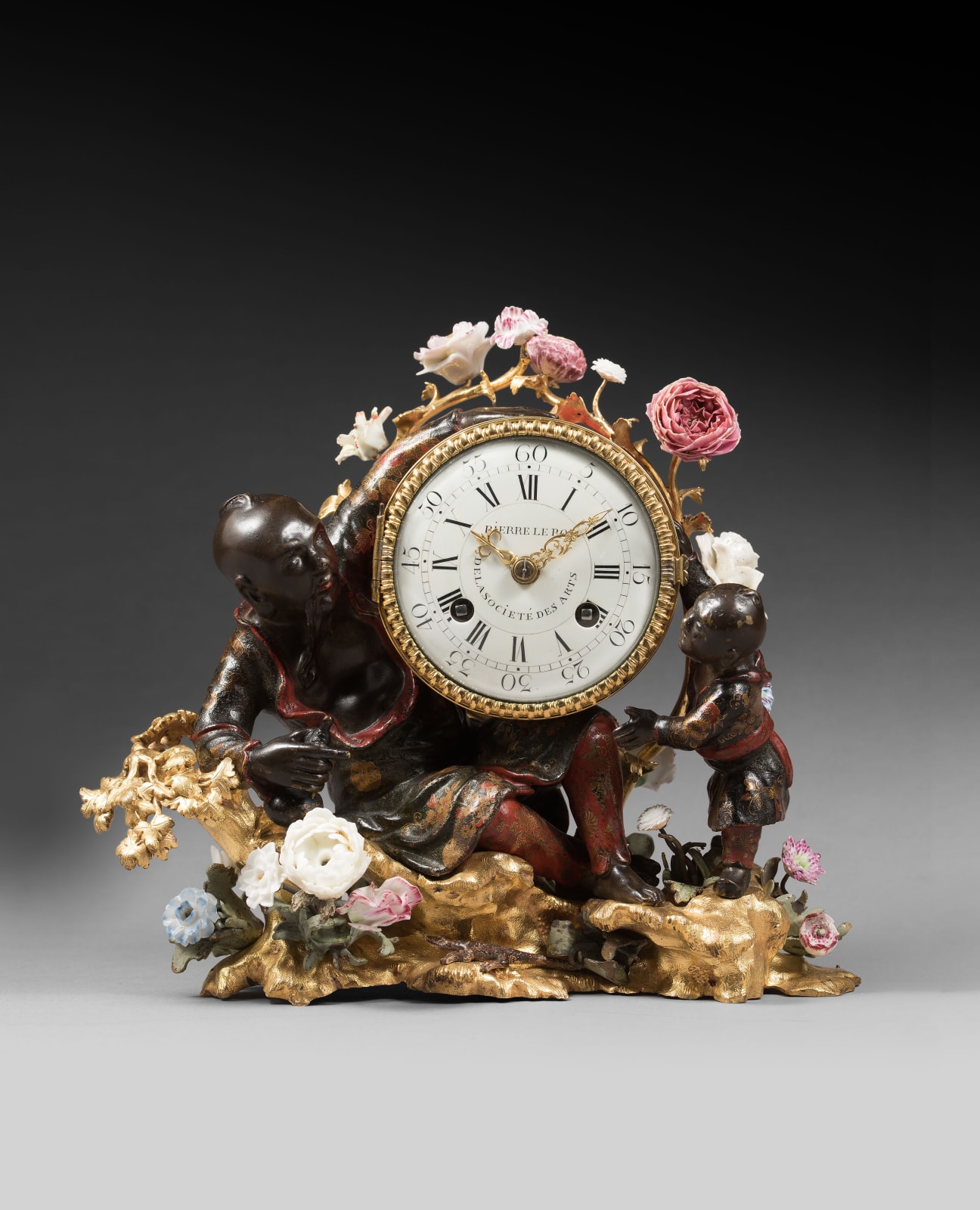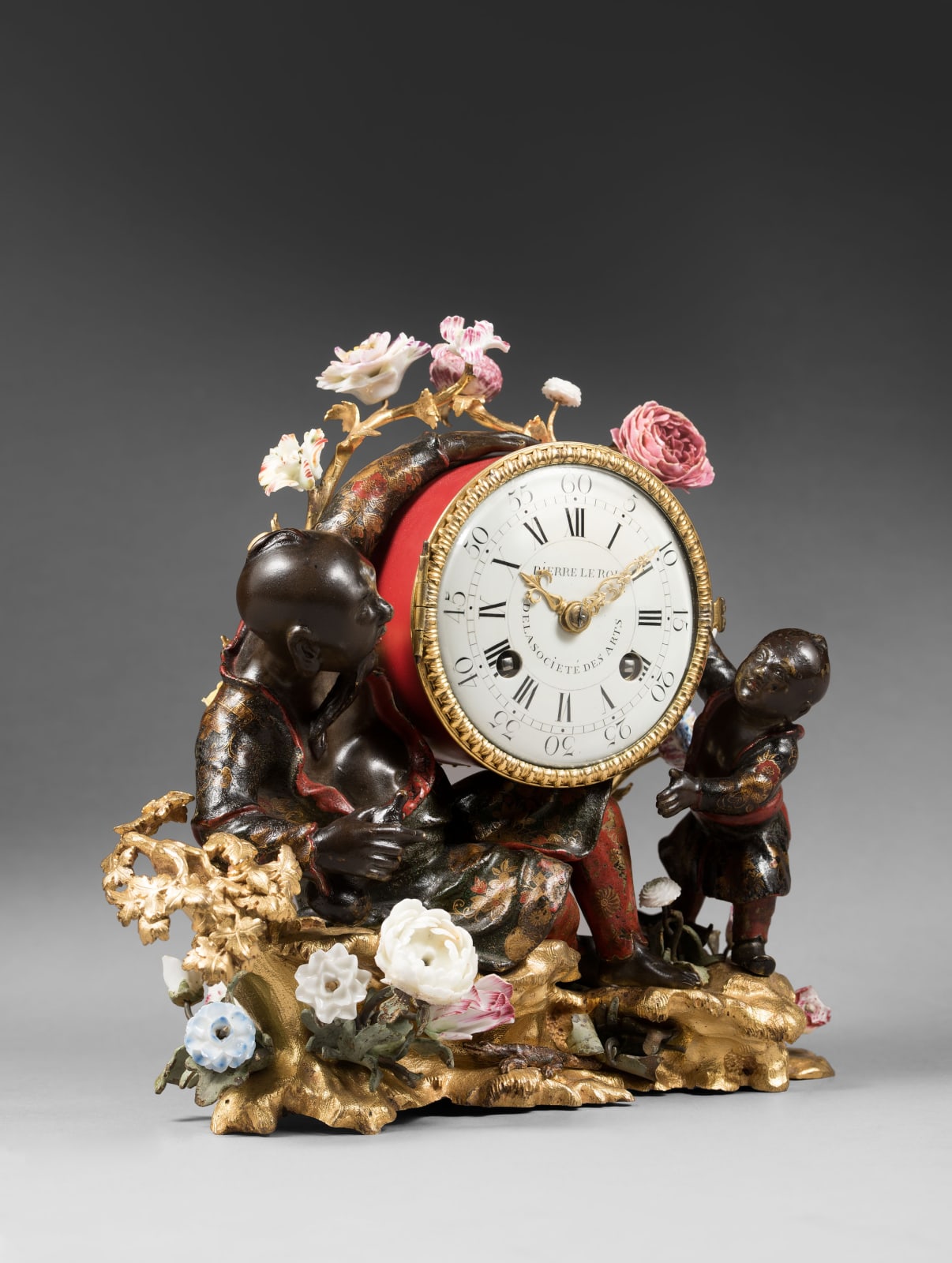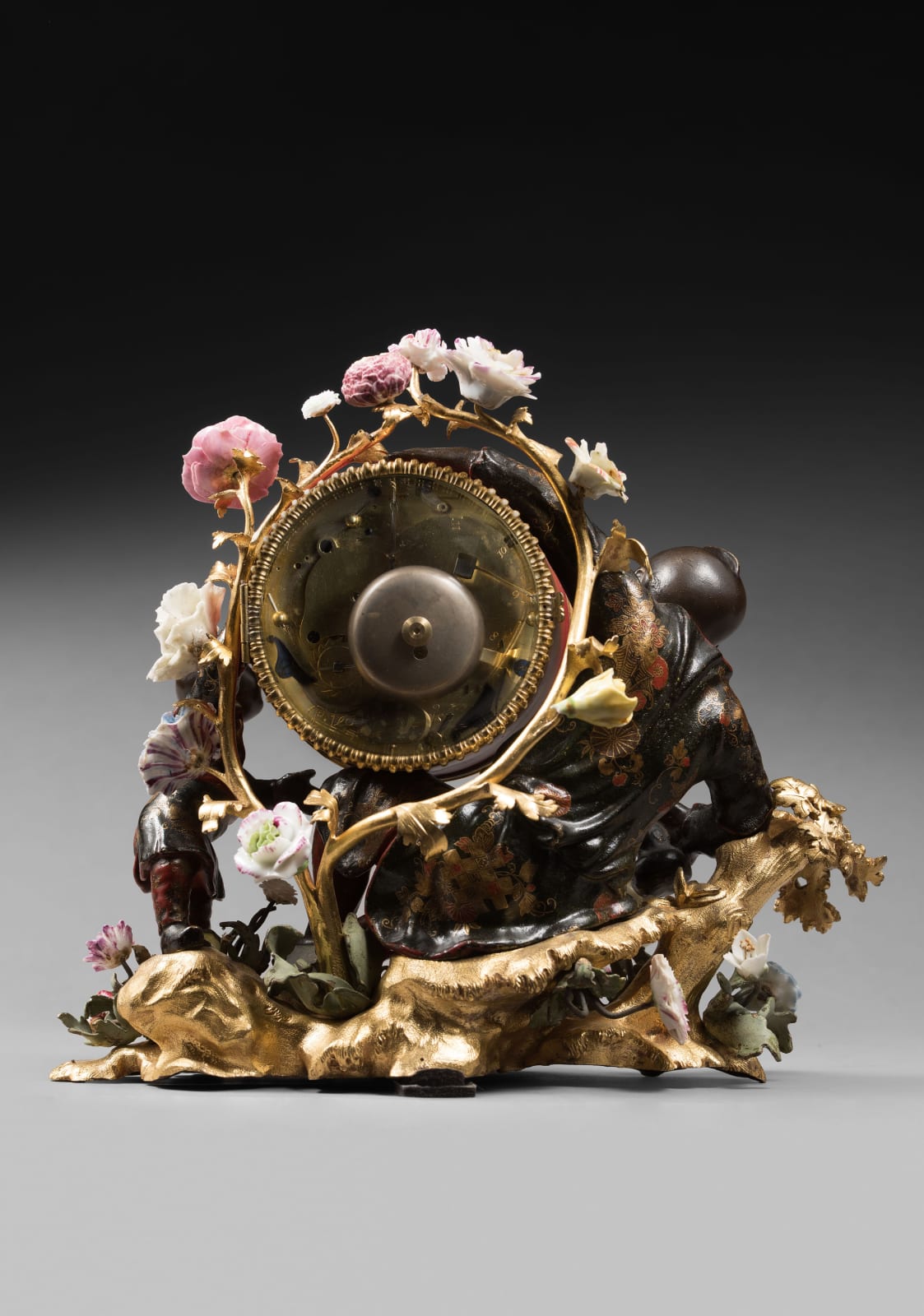Pierre II Le Roy
Further images
Provenance
The Rohan-Chabot Collection at the turn of the nineteenth and twentieth century. Thence by descent until recent years.
Literature
Simon Fleet, "Clocks, Pleasures and Treasures", 1967, p. 58, pl. 48, illustrating a similar clock with the same two figures but a different base, a greater profusion of flowering branches and dial signed Benoist Gerard à Paris. Pierre Verlet, "Les Bronzes Dorés Français", 1987, p. 21, no. 7, illustrating a similar type of clock, with three figures and movement by Julien le Roy, flanked by matching two-light candelabra to form a garniture, now in the Residenzmuseum, Munich. Jean-Dominique Augarde, "Les Ouvriers du Temps", 1996, p. 180, pl. 144, illustrating a similar type of clock with three Chinese figures and movement by Etienne Le Noir from the former collection of Mr and Mrs Djahanguir Riahi. Elke Niehüser, "Die Französische Bronzeuhr", 1997, p. 204, pl. 143, illustrating a very similar clock and pl. 144, illustrating a similar clock with the same two figures but a greater profusion of flowering branches. T. Wolvesperges, "A Propos d'une Pendule aux Magots en Vernis Martin du Musée du Louvre provenant de la Collection Grog-Carven" in "Revue du Louvre", 4th October 2001, pp. 66-78, with regard to a very similar clock in the Musée du Louvre, Paris from the Grog-Carven collection. Danielle Kisluk-Grosheide "The Reign of the Magots and Pagods", in "Metropolitan Museum Journal", vol. 37, 2002, pp. 177-97 and 183, pl. 13, illustrating a similar clock with movement by Etienne Le Noir.
A magnificent and rare Louis XV gilt bronze mounted polychrome painted vernis Martin and porcelain mantel clock of eight day duration by Pierre II Le Roy with magot figures attributed to Martin Frères, signed on the white enamel dial Pierre Le Roi/de la Societé des Arts and also signed on the movement, the dial with Roman and Arabic numerals and a fine pair of pierced gilt brass hands for the hours and minutes, the hour hand with a fleur-de-lis pointer. The movement with verge escapement, striking on the hours and half hours. The wonderful case with a reclining Chinaman resting the clock drum on his raised leg and steadying it with his left arm while holding a gourd-shaped drinking bottle in his right hand, with an infant standing on the right side of the drum with arms outstretched as if supporting it, the elder vernis Martin figure reclining on a gilt bronze tree and both on a gilt bronze rocaille base, decorated overall with naturalistic branches issuing exquisite porcelain peonies and other flower heads, probably from either the Vincennes or Meissen porcelain factories
Paris, date circa 1750
Height 27.5 cm, width 33 cm, depth 17 cm.
France's prolonged fascination with the Orient dates back to the mid seventeenth century when imported lacquered screens, porcelains and other wares were adapted into some of the most sophisticated and rarest objects. During the eighteenth century such Parisianmarchands-mercier as Simon-Philippe Poirier, Thomas-Joachim Hébert and Lazare Duvaux, who sought to capitalize on the huge demand for these rare objects, began to create their own versions of these prized imports. Using them for inspiration, along with contemporary engravings of the Chinese Emperor's court and designs by ornemantistes, the marchands-mercier created and promoted their own distinct taste known as the goût chinios, which was realized by a network of highly skilled artisans. These fanciful works were prized by the court of Louis XV and particularly by the celebrated connoisseur and royal mistress, Madame du Pompadour, who had a particular passion for chinoiserie and Japanese lacquer.
With its overt rococo decoration, brilliant colouring and highly skilled craftsmanship, the present clock is among one of the finest of a group made in mid eighteenth century Paris. Its overall design and assembly was due to one of the leading Parisian marchands-mercier, notably Simon-Philippe Poirier and Thomas-Joachim Hébert who would have commissioned various highly skilled craftsmen to supply the individual elements. The porcelain flowers are generally considered to have been made by either the Vincennes or Meissen porcelain factories while the movements for these clocks were made by leading Parisian clockmakers who, in addition to Pierre II Le Roy (1687-1762), included his younger brother Julian Le Roy (1686-1759), Etienne Le Noir as well as Mesnil, Balthazard, Paul Gudin and Jean-Baptiste Baillon.
The chinoiserie figures, often referred to as magots or pagodes where deliberately decorated to resemble the finest seventeenth century Japanese lacquer. Since the latter were becoming increasing more expensive to import, a number of Parisian craftsmen, known as vernisseurs began imitating this rare lacquer work. There were a number of makers who created lacquered chinoiserie figures to satisfy the huge demand for the goût chinois. However their fluid forms and refined decoration together with existing contemporary documentation concerning those adorning this type of clock, has led to the attribution to the Martin family. For two generations the Martins dominated this field, which was initially led by Guillaume Martin (1689-1749) and his younger brothers, Étienne-Simon (1703-1770), Julien (d. 1765), and Robert (1706-1765), who were the leading vernisseurs in Paris. The Martin brothers successfully developed a high quality varnish that they and subsequently their sons applied to such small luxury items as toilet sets, boxes, and etuis as well as to furniture, sedan chairs, carriages, and panelling. Due to their repute, aristocratic clientele and association with members of court, each of them was individually appointed vernisseur du roi.
From about 1750 onward vernis Martin came to be accepted as a general term for French imitation lacquer. Since none of the brothers signed their work, very few items can be attributed with certainty to a specific family member, especially since there were also a number of other vernisseurs working in eighteenth century Paris. However a number of inventory descriptions drawn up by the marchand-mercier Thomas-Joachim Hébert, who dealt directly with the Martins, specifically referred to 'verny de Martin' as opposed to the broader term 'verny commun' or 'verny de Paris'. Reference to magots or pagodes, explicitly said to be the work of the Martins can also be found in auction catalogues and inventories from the second half of the eighteenth century. As such it is reasonable to conclude that a number of the chinoiserie figures, especially those adorning luxury clocks, were indeed lacquered by members of the celebrated Martin family. Such was their renown that the Martin brothers were granted a Royal patent to protect their technique as well as a further patent in 1744 to produce lacquer wares en relief dans le goût du Japon et de la Chine. By 1748, they had opened the manufacture Royale de vernis de la chine.
In her discussion on the subject, Danielle Kisluk-Grosheide, op. cit., notes that at least nine pendules aux magots with two figures are known but none are identical. For instance, although the figures are nearly always lacquered in black, with red, brown, and gold decoration, the floral patterns of their garments are similar but never appear to be exactly the same. Again they are fitted with movements by a variety of highly reputed clockmakers and similarly the curving branches mounted with porcelain flowers and the shape of the gilt bronze base varies with each clock. It should be noted that until recently the present gilt bronze base had a supplementary lower section which we believed was a later addition; for that reason we had an expert remove it so as to restore it to how it was originally been conceived. Several types of clocks with three figures are also known; the most common of which features a pair of standing magots in long flowing robes lifting the drum of the clock together, while a girl or young woman, seated on top, looks down upon them. Among those with three figures one can cite a clock from the grand collection belonging to William Beckford, whose sale at Fonthill Abbey, 24th September 1823, included An ormolu fourteen-day repeating Bracket clock by Le Roi of Paris decorated with three Chinese Figures in bronze, coloured, curious and valuable.
The present clock compares most closely to one in the Musée du Louvre, Paris, formerly in the Grog-Carven collection. As here it is signed on the dial Pierre Le Roi de la Societé des Arts; it features the same two vernis Martin figures and it also rests on a very similar rocaille gilt bronze base from which issues porcelain flowers from either the Vincennes or Meissen factories. Another almost identical clock with lacquered chinoiserie figures attributed to Martin Frères and a movement by Etienne II Le Noir was almost certainly supplied to Prince Charles de Lorraine and was later in the Riahi collection. The Riahi collection also included a pendule aux magots with three figures, sold at Christie's New York, 2nd November 2000, lot 8. Other similar examples that have appeared more recently for sale include one from the collection of Martin Alexander, sold at Christie's, New York, 30th April 1999, lot 35 and subsequently sold anonymously at Christie's, New York, 20th April 2007, lot 154. Another with movement by Thiot formed part of a garniture including a pair of candelabra which was from the Jaime Ortiz Patiõ collection, sold Sotheby's, New York, 20th May 1992, lot 7 as well as one sold at Christie's, New York, 'An American Dynasty: The Clark Family Treasures', 18th June 2014, lot 115.
All of these clocks were made as luxury pieces exclusively for aristocratic or royal clientele and as such were in many major eighteenth century collections. Among similar examples, Kisluk-Grosheide op. cit. lists two clocks mentioned in an inventory prepared in 1740 after the death of the duc de Bourbon, prince de Condé, at the Château de Chantilly. One was signed on the dial Julien Le Roy while the other by Pierre Le Roy was described as: une pendule [sic] a repetiture[?] de Pierre Le Roy dans sa boite a Pagodes de Verny garnie de bronze dore d'or moulu prisée 300 livres. The inventory drawn up in 1752 after the death of the comte de Ruppelmonde also listed a similar clock with movement by our maker and two figures, described as Une pendulle faitte par Pierre Leroy soutenue par deux figures chinoises montées sur un pied le tout de bois verny de Martin 280 ls. In 1753, following the death of the comtesse Marie Françoise, Renée Turgot comtesse de Coubert her inventory included a clock similarly signed on the dial, noted as Une pendule du nom de Pierre le Roy de la Société des arts dans sa boete et sur son socle de cuivre doré orné de figures chinoises peintes en façon de lac (cited in D. Alcouffe, "Les Bronzes d'Ameublement du Louvre", 2004, p. 72). Of equal interest is the catalogue of Monsieur L-J Gaignat's collection by Pierre Rémy in 1768 which listed Une tres belle & grande Pendule, sonnant l'heure & la demi-heure, mouvement fait par Pierre le Roy. Elle est ornee de plusieurs figures de cuivre, représentant des magots vernis par Martin, imitant le laque: ils sont richement habilles & ouvragés de divers ors, sur une terrasse dont partie en rocher, & partie dorée & decorée de feuillages & de fleurs de Vincennes.
In addition to some of the above, it is possible that the present clock was the same as one owned by the great art collector the duc de Richelieu (1696-1788), which when sold along with the rest of his impressive collection from the hôtel de Richelieu, Paris, 18-30thDecember 1788, lot 693, was described as Une Pendule, mouvement de Pierre le Roi, dans sa boite, supportée par deux Magots de ton de laque en bronze, verni par Martin, sur sa terrasse. Louis-François-Armand Vignerot du Plessis, duc de Fronsac and later duc de Richelieu, was the great grandnephew of cardinal Richelieu and godson of Louis XIV and the duchess de Bourgogne. From 1743 onwards he held the position of Premier Gentilhomme de la Chambre before being named Maréchal de France in 1748. He was also a great connoisseur and armed with wealth, he amassed an impressive art collection to include paintings, furniture jewels and a number of gilt bronze mounted porcelain.
Our clock's importance not only rests on its beauty and quality of craftsmanship but also on account of Pierre II Le Roy who supplied the movement. He was born in Tours in 1686 and died in Paris on 15th February 1762. Like his brother Julien II Le Roy, who was later appointed Horloger Ordinaire du Roi, Pierre II Le Roy was trained by his father Pierre I Julien, a master clock maker from Tours. In 1710 he moved to Paris where he worked as a compagnon and ouvrier libre. He was then received as a maître horloger in October 1721 by a decree of June that year, exempting him from lack of an apprenticeship. As a mark of his standing he served as Garde-Visiteur of his guild from 1744 until 1748. Furthermore, he became a member of the Société des Arts, which he proudly noted on this clock dial as well others such as one with case adorned with a pair of Oriental porcelain lions and a Chinaman of c. 1735-40 which was made for Charles-Albert of Bavaria and is now in the Residenzmuseum, Munich (illustrated in Augarde, op. cit., p. 361, pl. 267). By 1722 Pierre II Le Roy was established at the cour de Lamoignon, he was then at Place Dauphine in 1738, followed by rue Dauphine in 1757 and finally at rue de Hurepoix in 1762.
An excellent clockmaker, Pierre II presented his inventions on four occasions to the Académie des Sciences, including a clock indicating real time and an equation circle (1728) as well as an escapement, known as à repos frottant, based on Debaufre's principle (1742). He also produced a few watches in association with his son-in-law David-Louis Carré though he is best known for his clocks. The cases for those were supplied by the leading bronziers of the day including Jean-Joseph de Saint-Germain, the Caffieris and Edme-Jean Gallien as well as those by the celebrated ébéniste Charles Cressent. As a leader in his field he enjoyed an impressive clientele which, in addition to the duc de Richelieu, included the Garde-Meuble de la Couronne, the prince de Condé, comte de Charolais, the duchesses d'Halincourt and du Maine, Madame de Montmartel, Madame Grimod du Fort, Bouret de Valroche as well as Eustache Bonnemet, L-J Gaignat and Monsieurs Montmorin, Beaujon and Julienne. Today one can admire his work in museums around the world such as the Patrimonio Nacional in Spain, the Musée International de l'Horlogerie at La Chaux-de-Fonds in Switzerland, the Bayerishes Nationalmuseum, Residenzmuseum in Munich, Château de Rosenborg in Copenhague and the Musée du Louvre in Paris. Certainly the present clock is worthy of being in an equally prestigious collection.





